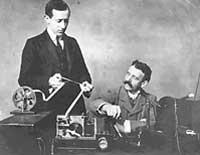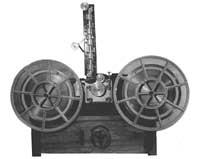Marconi, telecommunications leader

This Italian physicist surprised all the scientists of his time when he developed the transmission of wireless information at a distance. Although few thought that project was viable, he had a clear objective: The transmission between America and Europe across the Atlantic Ocean. Say and do. He turned to work and turned 25 with this feat.
Guglielmo Marconi was born in Bologna (Italy) in 1874, years before Hertz first produced electromagnetic waves. Since childhood he liked physics and electricity, and he repeatedly read the writings of Maxwell, Righi, Logde and Hertz himself. Hertz measured the wavelength and velocity of electromagnetic waves and found that the reflection and refraction of these waves were similar to those of light, so the luminous waves are electromagnetic radiations that follow Maxwell's law. All this surprised the young Marconi, who thanks to the fortune of his rich parents, including Bologna and Florence, had the opportunity to study physics and technology.
At age 21 he begins to experiment in the land of his parents. He created an electrical signal emission equipment in the air and took it to his house chamber. There he began to issue signals at small distances. From one end to the other of the attic, first, and from house to garden afterwards. In this way, the wireless signals were emitted two and a half kilometers away. This made him inventor of the first practical wireless telegraphy system.

The achievement did not arouse special interest in the Italian government, but after these first successful experiments in his country, Marconi became obsessed with sending messages from one side to the other of the Atlantic.
Thus, through his Irish mother he travelled to England in search of better sources of income. With his device under his arm he went to work on the English scammer and that same year he obtained the first worldwide patent of wireless telegraphy. The developed system proved it in London, testing on the Bristol channel and from there it dared at increasing distances. In 1897 it exceeded 30 km of distance to the Italian government and in 1899 launched wireless communication between England and France.

He was finally willing to realize his dream. In Poldhu, southeast England, he created a transmitter that could reach 100 times beyond any previous station. In 1901 he created in Newfoundland the wave detection station that would receive the signal across the Atlantic. Still no one believed it could succeed; they believed that the curvature of Earth would not allow the other side of the ocean to receive waves. But Marconi and his assistant Kemp kept their intention firm. Thus, after several years of work, on December 12, 1901, Marconi made his old dream come true. Marconi and his assistant heard the Morse signal from England at midnight with a clean pi-pi. And they hugged each other with joy, fascinated by that noise that expressed in morse ‘S’. In fact, they managed to exceed 3,600 kilometers away.
The ‘S’ became popular all over the world. Many scientists then became fascinated by the invention of great potential and immediately began to invent practical applications for that discovery. In fact, Marconi patented numerous inventions between 1902 and 1912.
Thus, The London Times and The New York Times echoed the war between Russia and Japan in 1903. On the other hand, the radio emerged from the inventions of Marconi, which in 1906 was broadcast for the first time the human voice via radio.

Another of the most prestigious uses of Moroccan radio was the radio room of the transatlantic Titanic. In the sinking this was the one who issued the first signal requesting help.
Thus, after so much success, in 1909 he received the Nobel Prize in Physics, together with the German Karl Ferdinand Braun. Finally, Marconi received recognition from Italy and was filled with awards and honors. He received several military medals and was appointed senator in 1914, marquis in 1929 and president of the Royal Italian Academy in 1930.
The trials carried out by this man were, therefore, those that founded the development of radio and other communication devices that we consider essential today. He took the first step in creating the global communications network.





